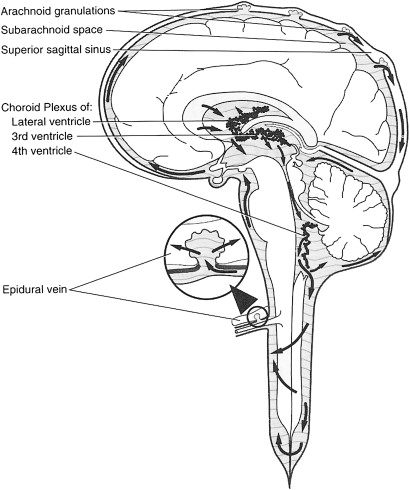This article serves as a concise review of cerebrospinal fluid metabolism and intracranial pressure regulation for otolaryngologists and lateral skull base surgeons. It examines the methodologies for maintaining cerebrospinal fluid homeostasis by preventing and treating acute elevations of intracranial pressure encountered during lateral skull base surgery.
Cerebrospinal fluid (CSF) leaks occur in 2% to 30% of lateral skull base procedures . Less appreciated are transient or intermittent increases in intracranial pressure (ICP), which can manifest as delayed arousal from anesthesia or persistently poor mental status after a prolonged procedure. Because of anatomic proximity to and manipulation of critical vascular structures in the neck and skull base, patients are at risk for ICP fluctuations with potentially severe sequelae. Understanding the basic principles of CSF formation and resorption, the connection of venous pressure to ICP, and arterial autoregulation is critical in designing safe surgical approaches in the lateral skull base.
This article serves as a concise review of CSF metabolism and ICP regulation for otolaryngologists and lateral skull base surgeons. It examines the methodologies for preventing and treating acute elevations of ICP encountered during lateral skull base surgery.
Cerebrospinal fluid metabolism and intracranial pressure regulation
In adults, the average CSF volume ranges from 90 to 150 cm 3 , with 40 cm 3 in the lateral ventricles. CSF is produced in the choroid plexus, a highly convoluted region of pia mater located throughout the intracranial ventricular system. CSF circulates by way of the foramen of Monroe into the third ventricle and continues through the sylvan aqueduct into the fourth ventricle. Flow continues through the subarachnoid space into the spinal canal via the foramina of Luschka (laterally) and Magendie (midline) into the spinal canal. CSF is absorbed into the cerebral venous system through arachnoid villi, which are located mainly in the sagittal sinus ( Fig. 1 ) .

CSF has four main functions. It provides physical support and buoyancy for the brain. This “water jacket” is protective because CSF volume fluctuates reciprocally with changes in intracranial blood volume to contribute to a safe ICP. Because the brain is devoid of a lymphatic system, byproducts of metabolism are principally removed by the capillary circulation or directly by transfer through the CSF. The direct CSF route is particularly important when increased amounts of lactic acid are produced in the brain. Finally, CSF maintains a safe chemical environment for brain tissues .
Because of the phenomenon of autoregulation, the brain is able to regulate arterial blood flow in accord with metabolic demand. Intracranial arterial blood flow is maintained constantly over a range of perfusion pressures from 60 to 150 mm Hg. Loss of autoregulation results in cerebral blood flow and blood volume passively fluctuating with changes in systolic pressure, which is most commonly seen in end-stage intracranial hypertension. Unlike the arterial system, the central venous system does not autoregulate. Acute fluctuations in venous pressure directly impact CSF pressure.
Normal limits of ICP range from 5 to 15 mm Hg or 65 to 195 mm H 2 O in the prone position. ICP varies with circulatory cycle and respiratory phase, age, and position. Factors that control ICP can be summarized as:
ICP = I f × R out + P ss
Stay updated, free articles. Join our Telegram channel

Full access? Get Clinical Tree


